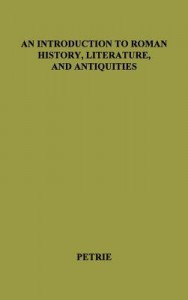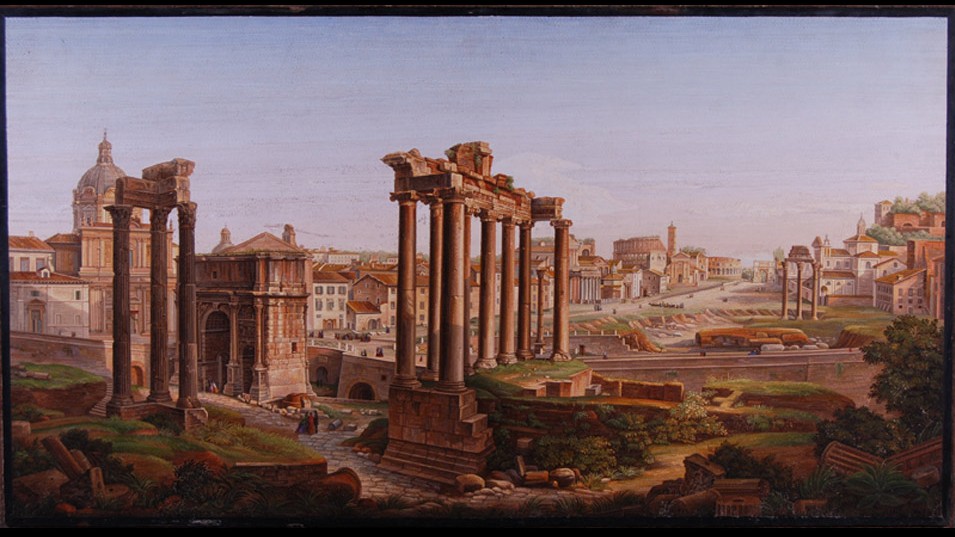A brief glimpse of the culture of Rome

Unfortunately this is not one of those books that you can simply go down to your local bookshop and buy off the shelf because I suspect that it is very long out of print. From what I gather from the introduction (and that is not taking into account that the entire book is an introduction) is that it is a companion to a Latin Reader and from reading the book it is quite clear that this is the case. What I found interesting was the number of Latin words that are used in the book, not in that chunks of the book are written in Latin, but rather when Petrie is describing an aspect of Ancient Rome, he will give us the Latin word that corresponds with it . For example, he will refer to the night guards, and give us the Latin word vigiliae, or refer to the winter camp, and say hiberna. What is this does is also gives us glimpses on how words in our own language – such as vigilant and hibernate – have come about.
The book is also interspersed with black and white pictures of statues, coins, and other works of art which also assist us in understanding the nature of Roman culture. One particular picture was a photo of the Forum taken around the time the book was written, and it was fascinating see the Forum back in the early 20th Century. Unfortunately I have not been able to find a replication of that picture, however I have found this picture:

Another fascinating thing that I have discovered about Ancient Rome is that we have a reasonably good idea as to what some of the major figures at the time looked like, thanks in part (actually not in part, but primarily because) of the life like statues that have been preserved. For instance, here is a statue of Julius Ceaser:

and here is a statue of Mark Antony:
and just because I feel that I should include him, here is a statue of one of Rome's greatest orators, Marcus Cicero:

Actually, there is a statue of Cicero standing outside the law courts in modern Rome, but that is beside the point.
While writing a book on the history of Rome can be quite a task, it is somewhat simpler to do than to also include in this short book an outline of Roman culture. The reason I say that is because we are dealing with a civilisation that was around for something like over a thousand years. To put it in perspective, the attitudes of Shakespearian England are substantially different to the attitudes of modern England, and in fact that attitudes towards marriage were different at the beginning of the 20th Century than they are now – for instance people did not live in defacto relationships in 1906, where as they are part an parcel of our society today. As such it is difficult at best (and impossible at worst) to be able to have a simple outline on the aspects of Roman society, and in the end you will only be able to capture a small part of the society, and even then there is the danger that we end up mixing two different eras due to the lack of information that we have (for instance, the Forum that we can walk around now is certainly not the Forum that Julius Ceaser and Marcus Cicero walked around – at the time the Colosseum did not exist). However, after reading this book I have now a much better understanding of the Roman political system as it existed at the later part of the Republican period, and this is something that I wish to discuss.
First of all Rome was not a democracy - far from it. Rather it was a Republic, which meant that it exists under the rule of law as opposed to the rule of a tyrant (though that changed with the ascension of Augustus Ceaser). Roman society was a very stratified society with four distinct classes of citizens, the patricians, the plebians, the resident foreigners, and the slaves. At the beginning only patricians could hold ruling titles, but after numerous struggles the plebians were able to attain such ranks, and then the resident foreigners were also given citizenship (not in the sense that they moved to Rome for a better life, but because the Romans invaded their territory, meaning that they had no choice but to live under their rule). Anyway, there are a number of parts that went to make up the Roman government, being the Senate, the Consuls, the Quaestors, the Praetors, the Tribunes, the Aediles, the Censor, and finally the Comitia.
Senate: this was the highest body in the Roman government, and while initially they acted as advisors to the king, and later to the Consuls, in time it became the chief legislative body. The interesting thing though is that they could not introduce legislation, they could only enact it, which meant that another arm of the government had to introduce the legislation. They would then debate it and in turn enact it. However, other arms could also enact legislation, which would lead to conflict. The senate was elected by the Comitia, but once elected to the Senate, you were elected for life.
Consul: there were two of these characters and they initially took over from the king. The reason that there were two was because the constitution did not allow power to be concentrated into the hands of one person (expect during emergencies, and then one could be appointed dictator). The Consuls in time simply became the commander in chief of the armies as other aspects of the government came about in an attempt to dilute the power. As the empire grew, the office of pro-consul was created so that foreign wars were able to continue under a single general without the need of returning to Rome to attempt to be elected for a second or third term. The term was for a year, and the most terms held by a single person was seven terms (they they were generally not concurrent) that being Marcius. Marcius died halfway through his seventh term.
Quaestor: these guys basically held the keys to the Roman treasury. It would be wrong to consider them with public servants in the sense that we understand them, but the closest that we could equate them to our time would the the members of the Federal Reserve. From what I gather the role of the Quaestor was to set economic policy, and also to facilitate the collection of the taxes (though they were substantially more important than a simple tax collector).
Praetor: these guys were the equivalent of our Supreme court judges. They pretty much held supreme judicial authority, however if one was convicted under a Praetor one had the right of appeal to the Comitia, which is sort of like appealing to the populace at large. We do not have a system like that in our society, though some times we wonder if the modern media does act like a defacto court.
Tribunes: We do not have an equivalent position in our society to the tribunes. Basically the tribunes represented the plebians, the common people, and held the power of veto if they believed that the legislation was not in the best interests of the people. We see this in action in the Shakespearian play Coriolanus, where the election of Coriolanus to the position of Consul is vetoed by the Tribunes, who then put forward a counter proposal of exiling him, which is then adopted. The office of tribune is one of the major reasons that the Roman Republic came to a constitutional crisis which resulted in its collapse and in turn the rise of the Imperium (and the emperor then took the role of the Tribune).
Aediles: From what I gather this role is pretty much a ceremonial role and was more connected with religious observance than anything else. Despite this, Rome was not really a religious nation. Rather it was more of a secular nation, though they did have their gods and their religious festivals. However, when you consider the persecutions of the Christians during the Empire you will discover that this is more of a secular and a state reaction rather than a religious reaction.
Censor: It is suggested that this was the highest office in the land, and is probably the equivalent of the chief public servant. However, he had no legislative power but rather ran the public service. He performed functions such as collecting census data (from which we get our word census) and also was pretty much in charge of the treasury. Sort of like all of the public servants rolled into one.
Comitia: Now this group is pretty much comprised of the citizens of Rome, and as such is very similar to the electorate of the modern day. In fact, the way the Comitia voted was similar to the way that we vote in our modern democracies, in that the Comitia were divided into groups, and the groups would vote as a whole. The Comitia would elect the various positions and would also act as the court of highest appeal.

 2
2


